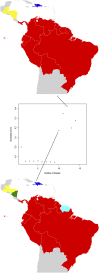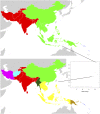International population movements and regional Plasmodium falciparum malaria elimination strategies
- PMID: 20566870
- PMCID: PMC2901446
- DOI: 10.1073/pnas.1002971107
International population movements and regional Plasmodium falciparum malaria elimination strategies
Abstract
Calls for the eradication of malaria require the development of global and regional strategies based on a strong and consistent evidence base. Evidence from the previous global malaria eradication program and more recent transborder control campaigns have shown the importance of accounting for human movement in introducing infections to areas targeted for elimination. Here, census-based migration data were analyzed with network analysis tools, Plasmodium falciparum malaria transmission maps, and global population databases to map globally communities of countries linked by relatively high levels of infection movements. The likely principal sources and destinations of imported cases in each region were also mapped. Results indicate that certain groups of countries, such as those in West Africa and central Asia are much more strongly connected by relatively high levels of population and infection movement than others. In contrast, countries such as Ethiopia and Myanmar display significantly greater isolation in terms of likely infection movements in and out. The mapping here of both communities of countries linked by likely higher levels of infection movement, and "natural" migration boundaries that display reduced movement of people and infections between regions has practical utility. These maps can inform the design of malaria elimination strategies by identifying regional communities of countries afforded protection from recolonization by surrounding regions of reduced migration. For more isolated countries, a nationally focused control or elimination program is likely to stand a better chance of success than those receiving high levels of visitors and migrants from high-transmission regions.
Conflict of interest statement
The authors declare no conflict of interest.
Figures




Similar articles
-
Human movement data for malaria control and elimination strategic planning.Malar J. 2012 Jun 18;11:205. doi: 10.1186/1475-2875-11-205. Malar J. 2012. PMID: 22703541 Free PMC article. Review.
-
Ecology, economics and political will: the vicissitudes of malaria strategies in Asia.Parassitologia. 1998 Jun;40(1-2):39-46. Parassitologia. 1998. PMID: 9653730
-
Imported Plasmodium falciparum and locally transmitted Plasmodium vivax: cross-border malaria transmission scenario in northwestern Thailand.Malar J. 2017 Jun 21;16(1):258. doi: 10.1186/s12936-017-1900-2. Malar J. 2017. PMID: 28637467 Free PMC article.
-
Quantifying cross-border movements and migrations for guiding the strategic planning of malaria control and elimination.Malar J. 2014 May 3;13:169. doi: 10.1186/1475-2875-13-169. Malar J. 2014. PMID: 24886389 Free PMC article.
-
Challenges for malaria elimination in Brazil.Malar J. 2016 May 20;15(1):284. doi: 10.1186/s12936-016-1335-1. Malar J. 2016. PMID: 27206924 Free PMC article. Review.
Cited by
-
Recent Travel History and Plasmodium falciparum Malaria Infection in a Region of Heterogenous Transmission in Southern Province, Zambia.Am J Trop Med Hyg. 2020 Aug;103(2_Suppl):74-81. doi: 10.4269/ajtmh.19-0660. Am J Trop Med Hyg. 2020. PMID: 32618250 Free PMC article.
-
Comparing metapopulation dynamics of infectious diseases under different models of human movement.Proc Natl Acad Sci U S A. 2021 May 4;118(18):e2007488118. doi: 10.1073/pnas.2007488118. Proc Natl Acad Sci U S A. 2021. PMID: 33926962 Free PMC article.
-
Using mitochondrial genome sequences to track the origin of imported Plasmodium vivax infections diagnosed in the United States.Am J Trop Med Hyg. 2014 Jun;90(6):1102-8. doi: 10.4269/ajtmh.13-0588. Epub 2014 Mar 17. Am J Trop Med Hyg. 2014. PMID: 24639297 Free PMC article.
-
Genetics of chloroquine-resistant malaria: a haplotypic view.Mem Inst Oswaldo Cruz. 2013 Dec;108(8):947-61. doi: 10.1590/0074-0276130274. Mem Inst Oswaldo Cruz. 2013. PMID: 24402147 Free PMC article. Review.
-
Towards malaria elimination in Mpumalanga, South Africa: a population-level mathematical modelling approach.Malar J. 2014 Aug 3;13:297. doi: 10.1186/1475-2875-13-297. Malar J. 2014. PMID: 25086861 Free PMC article.
References
-
- Barat LM. Four malaria success stories: How malaria burden was successfully reduced in Brazil, Eritrea, India, and Vietnam. Am J Trop Med Hyg. 2006;74:12–16. - PubMed
Publication types
MeSH terms
Grants and funding
LinkOut - more resources
Full Text Sources

